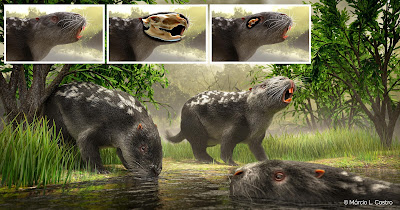 |
| Josephoartigasia monesi Rinderknecht & Blanco, 2008 in Ferreira, Rinderknecht, de Moura Bubadué, Gasparetto, Dozo, Sánchez-Villagra et Kerber, 2024. the Neuromy of and the of in Caviomorph Rodents. |
Abstract
Caviomorph rodents are an exceptional model for studying the effects of ecological factors and size relations on brain evolution. These mammals are not only speciose and ecologically diverse but also present wide body size disparity, especially when considering their fossil relatives. Here, we described the brain anatomy of the largest known rodent, Josephoartigasia monesi, uncovering distinctive features within this species regarding other taxa. Albeit resembling extant pacarana Dinomys branickii, J. monesi stands out due to its longer olfactory tract and well-developed sagittal sinus. Challenging the previous hypothesis that giant rodents possessed comparatively smaller brains, we found that J. monesi and another giant extinct rodent, Neoepiblema acreensis, are within the encephalization range of extant caviomorphs. This was unraveled while developing the a Phylogenetic Encephalization Quotient (PEQ) for Caviomorpha. With PEQ, we were able to trace brain-size predictions more accurately, accounting for species-shared ancestry while adding the extinct taxa phenotypic diversity into the prediction model. According to our results, caviomorphs encephalization patterns are not the product of ecological adaptations, and brain allometry is highly conservative within the clade. We challenge future studies to investigate caviomorphs encephalization within different taxonomic ranks while increasing the sampled taxa diversity, especially of extinct forms, in order to fully comprehend the magnitude of this evolutionary stasis.
Keywords: Adaptive regimes, Allometric trends, Brain evolution, Cranial endocast, South America, Brain Structure and Function
 |
| Artistic reconstruction of Josephoartigasia monesi. Art by Márcio L. Castro |
José Darival Ferreira, Andrés Rinderknecht, Jamile de Moura Bubadué, Luiza Flores Gasparetto, Maria Teresa Dozo, Marcelo R. Sánchez-Villagra and Leonardo Kerber. 2024. Unveiling the Neuroanatomy of Josephoartigasia monesi and the Evolution of Encephalization in Caviomorph Rodents. Brain Structure and Function. 229; 971–985. DOI: doi.org/10.1007/s00429-024-02762-y
